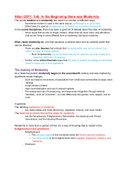Samenvatting
Midterm summary for Sustainability Politics (readings)
- Vak
- 73220042FY
- Instelling
- Universiteit Van Amsterdam (UvA)
The summary is filled with content from the required readings necessary for the midterm exam. This includes the authors and sub-headings that will facilitate exam preparation. With this summary, I managed to get a 7.5 in my midterm.
[Meer zien]




